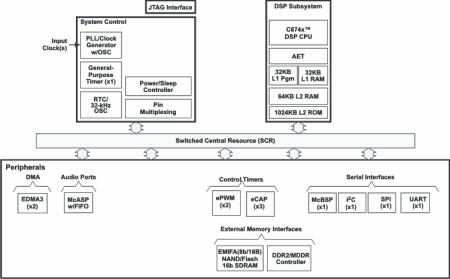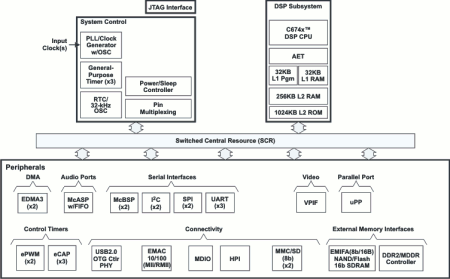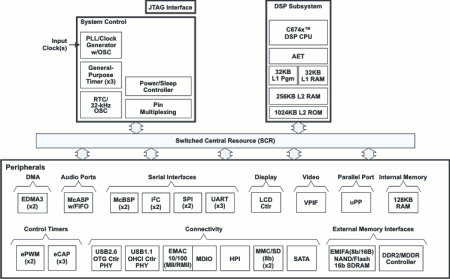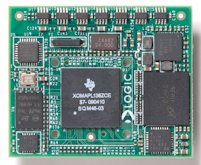Linux-ready SOC offers low-power DSP
Jun 29, 2009 — by Eric Brown — from the LinuxDevices Archive — 42 viewsTexas Instruments (TI) is sampling three new digital signal processors (DSPs) touted as being the lowest-power floating point DSPs in the industry. In addition to launching the TMS320C6742, TMS320C6746, and the SATA-enabled TMS320C6748, TI is also sampling a Linux-ready, ARM9-based OMAP-L138 system-on-chip (SoC) that incorporates the TMS320C6748, says the company.
TI says its new C674x DSPs are targeted at a wide range of embedded products, including industrial, communications, medical diagnostics, and audio, says TI. The DSPs run on a claimed 7mW of standby power at 1.0V/25 degrees C, which TI claims is up to nine times lower than existing floating-point DSPs. The DSPs are said to run on 420mW total power during regular operation.
The new OMAP-L138 SoC, meanwhile, pairs one of the three C674x DSPs (typically the higher-end C6748) DSPs with a 300MHz ARM926EJ-S core, allowing developers to add human machine interfaces (HMI), as well as applications that support touchscreen or networking capability. Currently, the OMAP-L138 supports only Linux, but Windows Embedded CE and Integrity OS support is promised for the fourth quarter.
The C674x DSPs
TI says multiple operating points on its new DSPs can be facilitated through a Dynamic Voltage And Frequency Scaling (DVFS) feature, says TI. DVFS is said to power off unused peripherals and provides for selectable I/O voltages, enabling portability and reduce heat dissipation, says the company.

C6742 block diagram
(Click to enlarge)

C6746 block diagram
(Click to enlarge)
With its SATA support, and extensive communications I/O, the C6748 (diagram below) is especially suitable for applications that require both storage and communications, including test and measurement, public safety radios, music effects, and intelligent occupancy sensors, says TI. In addition, the C6746 and C6748 models are equipped with a universal parallel port (uPP) for high-speed connections to data converters, FPGAs (field programmable gate arrays), or other C674x DSPs. (For more details, see the spec list below and compare the block diagrams.)

C6748 block diagram
(Click to enlarge)
- EMAC, MMC/SD, and high-speed USB 2.0/1.1 interfaces
- LCD controller and video port interface
- Dynamic voltage and frequency scaling (DVFS)
- Complementary TI TPS65070 power management device that is said to implement all sequence and default options, and support power modes
- C674x DSP core clocked up to 300MHz, with floating-point operations for high-precision and wide dynamic range, and fixed-point operations for performance
- 128KB to 448KB on-chip memory
The OMAP-L138
By tapping a DSP's DVFS capability and multiple power-down modes, the OMAP-L138 is especially well-suited for power protection systems, costing up to $14 less than current solutions, says TI. The claimed 440mW total power usage is only slightly higher than that of any of the DSPs on their own, although the standby mode power is about twice as high, at 15mW.

OMAP-L138 block diagram
(Click to enlarge)
A computer module and a larger "experimenter board" are said to be available for the OMAP-L138 via Logic, which often furnishes development boards and computer modules for TI's processors. The $150 experimenter board is equipped with the OMAP-L138 and 64MB mDDR, and is offered with a Linux development system that supports development of all three DSPs.
A more full-featured, $1,200 evaluation module (EVM) version of the board is available from TI, pairing the OMAP-L138 with a second C6748 DSP, and offering peripheral access and TI support. The TI EVM is said to double the memory (128MB mDDR), and offer "full support for connectivity peripherals."
 Logic's OMAP-L138 SOM-M1 computer module |
Logic's OMAP-L138 SOM-M1 computer module is a "production-ready solution" that offers 128MB mDDR, power management, and Ethernet PHY, among other interfaces. Logic's Linux platform for both the module and experimenter's board includes the following, says Logic:
- Open source Linux Board Support Package (BSP)
- U-Boot (bootloader/monitor)
- Code Composer Studio (CCS) v3.3
- DSP/BIOS
- Board Support Library (BSL) sample programs
Key specifications listed for the OMAP-L138 when paired with the high-end C6748 DSP include:
- ARM core — 300MHz ARM926EJ-S RISC core with 32-bit and 16-bit (Thumb) instructions; 64KB L1 cache; 256KB L2 cache
- C6748DSP core — 300MHz C6748 VLIW DSP:
- Load-store architecture with non-aligned support
- 64 general-purpose registers (32-bit)
- 6 x ALU (32-/40-Bit) functional units
- 2 x multiply functional units
- C6748 DSP two-level cache memory architecture:
- 32KB L1P program RAM/cache
- 32KB L1D data RAM/cache
- 256KB L2 unified mapped RAM/cache
- Flexible RAM/cache partition (L1 and L2)
- 1024KB Boot ROM
- Enhanced Direct-Memory-Access Controller 3 (EDMA3):
- 2 x channel controllers
- 3 x transfer controllers
- 64 independent DMA channels
- 16 quick DMA channels
- LVCMOS IOs — 1.8V or 3.3V (except for USB and DDR2 interfaces)
- External memory interfaces — EMIFA; DDR2/Mobile DDR memory controller; supports Async SRAM, SDRAM, DDR2, mDDR, NAND Flash, and NOR
- Memory expansion — 2 x Multimedia Card (MMC)/Secure Digital (SD) Card interfaces with Secure Data I/O (SDIO) interfaces
- Storage — Serial ATA (SATA I and II) controller
- Display — LCD controller; Video Port Interface (VPIF)
- Audio — 1 x multichannel audio serial port (McASP)
- Networking — 1 x 10/100 Ethernet MAC (EMAC)
- USB — 1 x USB 1.1 OHCI (Host); USB 2.0 OTG Port; both with integrated PHY
- Serial — 2 x multi-channel buffered serial ports
- SPI — 2 x Serial Peripheral Interfaces (SPI)
- Parallel — 1 x Universal Parallel Port (uPP)
- UART — 3 x configurable 16550 type modules
- I2C — 2 x master/slave Inter-Integrated Circuit (I2C Bus)
- HPI — 1 x Host-Port Interface (HPI) with 16-bit-wide muxed address/data bus
- Other features:
- Real-time clock with 32KHz oscillator
- 2 x 64-bit general-purpose timers
- 64-bit general-purpose timer (Watchdog)
- 2 x Enhanced Pulse Width Modulators (eHRPWM)
- 2 x 32-bit Enhanced Capture Modules (eCAP)
- 2 x PWM
- Operating temperature — 32 to 194 deg. F (0 to 90 deg. C); extended version -40 to 221 deg. F (-40 to 105 deg. C)
- Power — Core supply 1.2 V; I/O supply 1.8 V, 3.3 V
- Packaging — 361-Ball Pb-Free Plastic Ball Grid Array (PBGA), with either ZCE suffix (0.65mm ball pitch) or ZWT suffix (0.80mm)
- Operating system — Linux (Windows Embedded CE and Integrity to be supported in 4Q 2009
Availability
The three new TMS320C674x DSPs and the OMAP-L138 SoC are now available for sampling. The processors and related development boards and modules are priced as follows:
- TMS320C6742 — $6.70
- TMS320C6746 — $13.50
- TMS320C6748 — $15.20
- OMAP-L138 — $18.60 (1,000 units)
- OMAP-L138/C6748 EVM — $1,200
- Logic OMAP-L138 experimenter's board — $150
- Logic OMAP-L138 SOM-M1 module — under $100
More information on the OMAP-L138 may be found here. More information on the TMS320C6748 DSP may be found here. More information on the OMAP0L138 EVM may be found here. More information on Logic's OMAP-L138 SOM-M1 computer module may be found here.
This article was originally published on LinuxDevices.com and has been donated to the open source community by QuinStreet Inc. Please visit LinuxToday.com for up-to-date news and articles about Linux and open source.